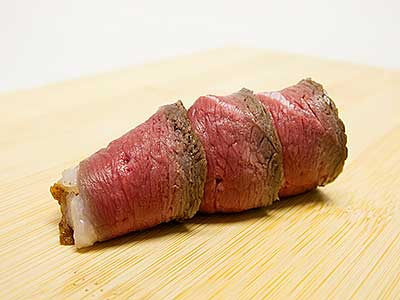November 11, 2013
Amuse-Bouche

magret de canard mariné
(pickled duck breast)
Universal education is the cornerstone of democracy. And the recognition of this fact may be called the great American contribution. But in our society the fullest self-realization depends upon a well balanced knowledge of scientific facts, upon a rounded culture. Thus education, properly conceived, is a preparation for intelligent, ethical, and contented citizenship.
Thus Winston Churchill wrote in 1918 in his book: A Traveller in War-time: With an Essay on the American Contribution. Unfortunately, our legislative bodies in the various jurisdictions that make up the United States of America often create laws without “a well balanced knowledge of scientific facts.” Case in point: California SB1520, the criminalization of foie gras production and any product resulting from foie gras production.
When the bill was passed in 2004, its sponsor made the cause a “motherhood and apple pie” issue. No legislator was willing to spend the necessary political capital to defeat the bill. The one-sided committee meetings held in the legislature to discuss the proposed bill were generously reported by a news media unwilling to question the press releases it was given by pro-ban forces.
At the time, there was only one producer of foie gras in the state. The company was being continually attacked with frivolous laws suits that were draining its financial resources. In the end, the company acquiesced to the law in exchange for a provision in the bill that prohibited the lawsuits.
Although at times during my French stages I was “knee-deep” in foie gras, in the years leading up to the ban taking effect, I probably only prepared it at home once or twice a year. That was not the case for one of the products that is now in violation of section 25982 of the law. The Moulard duck used to produce foie gras also produces two large, succulent breasts. Whereas the normal ducks used for meat production produce a breast that dresses out with the skin at about 225 g (8 oz), the breast from a foie gras duck can easily weigh 450 g (1 lb). When roasted to a medium-rare, the resulting meat is tender, juicy, and flavorful. For years, I always had one or two Cryovac bags with a pair of foie gras duck breasts in my freezer. This summer, a year after the law went into effect and my source dried up, I defrosted my last bag.
The occasion was a French-style Sunday dinner that I was preparing for a chef friend and her new husband. A couple of days before the meal, I realized that the weather may be hot the afternoon of the meal. With a few adjustments, thirteen of the fifteen dishes became cold dishes. To serve the duck breasts cold, I decided some pickling may be in order.
The idea to pickle duck breasts was not original. A few weeks earlier, I had eaten the preparation as part of an appetizer at Timberyard in Edinburgh, Scotland. The menu description simply read: “pickled duck, foraged leaves, hazelnut, horseradish cream.” After my meal, I approached Chef Ben Radford for a few details about the duck. The server had claimed that the meat was pickled before cooking, but the chef clarified that a cooked duck breast was soaked in a simple vinegar pickling solution overnight. So that’s what I did.
I diamond scored the skin, sprinkled both sides of the breasts with salt and freshly ground black pepper, and seared them over high heat. They were then placed in a 215 °C (420 °F) oven until the internal temperature reached 41 °C (113 °F). When they came out of the oven, I transferred them to a plate, loosely covered them with foil and a heavy towel, and set them aside to cool.
While the meat was cooling, I prepared a simple brine of one part white wine vinegar, one part filtered water, and one part granulated sugar. I used my Bamex to hasten the dissolving of the sugar. When the breasts were cooled to room temperature, they were submersed in the pickling solution and placed in the refrigerator overnight.
The following morning, the breasts were removed from their overnight soak, drained well, rinsed in cold water, dried with paper towels, set on a plate, and returned to the refrigerator, uncovered, to completely dry their surfaces. To serve the meat, the breasts were thinly sliced across the grain. They were served as part of the main course, but after the four servings were sliced from the two breasts, there was still a half of a breast remaining. This was set aside in the refrigerator until the next morning.
The following morning, I sliced the leftover half breast into 24 slices, enough for eight portions as an amuse-bouche. Sets of three slices were wrapped as a group in parchment paper, and four sets each were sealed in vacuum bags. They now sit in my freezer awaiting the appropriate occasion for serving.
© 2013 Peter Hertzmann. All rights reserved.
